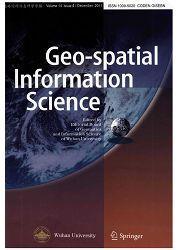多源数据实时区域校正对流层多项式系数的卡尔曼滤波
IF 5.5
1区 地球科学
Q1 REMOTE SENSING
引用次数: 0
摘要
对流层延迟对全球卫星导航系统(GNSS)的高精度定位有重要影响。传统的解决方案有其弱点。首先,对流层延迟作为状态参数的估计会减慢定位滤波器的收敛速度,这对精确点定位(PPP)尤为重要。其次,基于校正的方法,包括经验模型、气象模型和GNSS网络观测,都有其相应的局限性。经验模型包括基于年数据的统计,忽略了高时间变化成分,导致校正精度降低。气象模式需要实时的本地天气观测。可以启用昂贵的GNSS站点区域基础设施的网络方法,其性能取决于漫游车网络的几何形状。在这项研究中,我们通过卡尔曼滤波的多项式系数实现了对流层区域实时校正服务,这些数据包括全球压力和温度2 (GPT2w)模式、美国国家海洋和大气管理局(NOAA)的天气观测和GNSS网络观测。在讨论了浙江省区域数据集检验的加权策略之后,我们以后处理的PPP结果为参考,评估了所提出的融合方法的性能。在静态、活动和整体天气条件下,天顶对流层延迟(ZTD)的平均精度分别为0.43和1.20 cm。与实时GNSS网络ZTD方案相比,我们提出的融合方案分别提高了48.21%、55.20%和41.70%。综上所述,该方法充分利用了三种传统的基于校正的方法,提供了优化的对流层实时服务。本文章由计算机程序翻译,如有差异,请以英文原文为准。
Tropospheric polynomial coefficients for real-time regional correction by Kalman filtering from multisource data
The tropospheric delay has a significant impact on high-accuracy positioning of the Global Navigation Satellite System (GNSS). Traditional solutions have their weaknesses. First, the estimation of tropospheric delay as a state parameter slows the positioning filter’s convergence, especially critical for Precise Point Positioning (PPP). Second, correction-based approaches, including empirical model, meteorological model and GNSS network observations, have their corresponding limitations. The empirical model comprises yearly data-based statistics, which ignores high temporal-variation components, leading to decreased correction accuracy. The meteorological model requires real-time local weather observations. One can enable the network method of the expensive regional infrastructure of GNSS stations, of which performance depends on the rover-network geometry. In this study, we enable a real-time tropospheric regional correction service by polynomial coefficients from the Kalman filtering of multisource data, including the Global Pressure and Temperature 2 wet (GPT2w) model, weather observations from the National Oceanic and Atmospheric Administration (NOAA), and GNSS network observations. After discussing the weighting strategy examined by the regional dataset from Zhejiang Province, we evaluate the performance of the proposed fusion approach with post-processed PPP results as references. We obtained the optimal weightings for the corresponding dataset, and the average accuracy for Zenith Tropospheric Delay (ZTD) is 0.43, and 1.20 cm under static, active, and overall weather conditions, respectively. Compared with the real-time GNSS network ZTD solution, our proposed fusion solution is improved by 48.21%, 55.20%, and 41.70%, respectively. In conclusion, the proposed approach makes the best of three traditional correction-based methods to provide optimized real-time tropospheric service.
求助全文
通过发布文献求助,成功后即可免费获取论文全文。
去求助
来源期刊

Geo-spatial Information Science
REMOTE SENSING-
CiteScore
10.10
自引率
28.30%
发文量
710
审稿时长
31 weeks
期刊介绍:
Geo-spatial Information Science was founded in 1998 by Wuhan University, and is now published in partnership with Taylor & Francis. The journal publishes high quality research on the application and development of surveying and mapping technology, including photogrammetry, remote sensing, geographical information systems, cartography, engineering surveying, GPS, geodesy, geomatics, geophysics, and other related fields. The journal particularly encourages papers on innovative applications and theories in the fields above, or of an interdisciplinary nature. In addition to serving as a source reference and archive of advancements in these disciplines, Geo-spatial Information Science aims to provide a platform for communication between researchers and professionals concerned with the topics above. The editorial committee of the journal consists of 21 professors and research scientists from different regions and countries, such as America, Germany, Switzerland, Austria, Hong Kong and China.
 求助内容:
求助内容: 应助结果提醒方式:
应助结果提醒方式:


